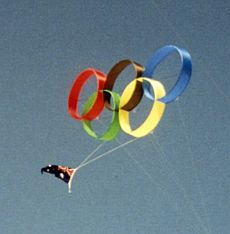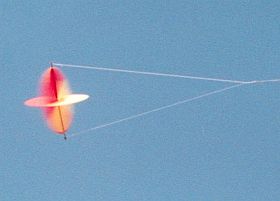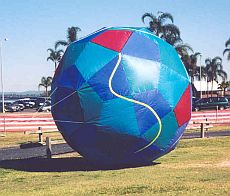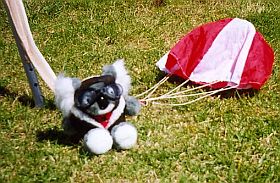An Interview With Anthony Thyssen
This interview with Anthony Thyssen was conducted on 28 February 2011. (This page is in Australian English)
On this site, there's more kite-making info than you can poke a stick at :-)
Want to know the most convenient way of using it all?
The Big MBK E-book Bundle is a collection of downloads—printable PDF files which provide step-by-step instructions for many kites large and small.
Every kite in every MBK series.
1. What can you remember about your very first kiting experiences? Were you 'right into' the hobby from then on, or did it gradually grow on you over time?
 Anthony Thyssen
Anthony ThyssenAs a boy I'd always been fascinated by things that flew. I made
my own working boomerangs by filing the airfoil out of some plywood. My
first kite was a Peter Powell stunt kite, and I remember flying it in
the strong winds as one of the famous Brisbane summer storms approached.
But the moment that clinched it for me was this yellow-and-red plastic aeroplane kite in which the wings rotated. I would peg it to the ground and lie down on the grass underneath, just staring at it in the sky.
Of course, senior high school and university demands intervened, and I didn't get much time for it after that. At least not until I had my first full-time graduate job.
I was living in Adelaide then, just around the corner from the beach in Brighton, where I started trying to build kites from dowel, plastic and old umbrellas. Since then I never really stopped flying.
2. As you explored the world of kites, were there any forays into multi-line building or flying? If so, how did single liners win out in the end?
Well, I did try to make some stunt kites as a kid. Typically diamond kites with two strings. I can remember finding that wider kites were more maneuverable. Hence, my successive stunt diamonds became wider and wider and naturally more wild and unstable. But it was all fun.
I did make single-line kites, but I was actually more interested in trying to build line-climbing devices than flying them.
My passion for single lines came later when I returned to Brisbane after Adelaide. I kept seeing these weird old kites designed in books and just tried to build them. The more unusual the better. UFO rotor kites were my big thing and in a way they still are.
3. Which of your own designs has given you the most pleasure and satisfaction, and why?
 Circoflexi celebrate the Olympics
Circoflexi celebrate the OlympicsFinally getting my first circoflex to fly, after trying again and
again getting it just right, was close. I and many others find them just
magical. I still find it a little hard to believe that they actually do
fly.
The problem is larger ones are temperamental, needing constant attention. So I tend to fly my mini-circo's (1.2 meter diameter) more.
As for the more pleasure – that would have to have been the idea to actually link mini-circoflexi together to form a flying Olympic logo. It was great flying it on the Townsville Strand on the afternoon the Olympic torch was to arrive (see photo). In many ways it set the mood of the whole event, even if I was not strictly part of the organised festivities.
4. You have a particular interest in 'unusual kites', such as tetras and the circoflex. Of all these, which individual kite do you think has provoked the most reaction or emotion from onlookers? In what way?
 Awesome vibrations down the line
Awesome vibrations down the lineTetrahedral kites are interesting in that you can create what looks
like large solid 'blocks' in the sky. But they don't seem to provoke a
lot of reaction from onlookers. They are just boring blocks. However,
they are a rare sight, as they are just so difficult to transport,
prepare and put away again.
The circoflex, being a reasonably large kite, gets more attention from onlookers, most of whom (like me) can't really believe it is up there!
But the best reaction I get from people is when I simply hand someone the kite line of a fast-spinning UFO kite (see photo). The unexpected vibrations they feel on the line are just awesome.
5. Tell us a little about the kite which consumed the most build time, of all your own creations. Cumulative or elapsed time, take your pick... Or maybe it was both!
The kite which took the most effort is, well, not strictly a kite at all...
My Kite Ball was a 4-meter diameter ball, made from 60 kite-shaped pieces. This was the final large project I made before getting hitched. As your readers should know by now, I like the unusual, so when I decided I would build a ball, I did not want just a soccer ball.
For this, I ended up devoting 6 months of my recreational time in research and doing three-dimensional studies and computer programming into mathematical spheres. I am overtly mathematical in my thinking, and this was going all out.
 Bouncing rather than flying
Bouncing rather than flyingSix months of study, many new programs, and a website of my work, and
I finally settled on a specific mathematical object known as a 'kite
hexacontrahedron'. I purchased some ripstop nylon, which was the first
time for any major kite project. Then I started filling my lounge room
with large slipper material for three months, before finally finishing
the ball.
I was disappointed that the front ripped out in gale force winds at Bondi a few months later, but the ball came out stronger and more solidly built after that.
Since then the Kite Ball (see photo) has been a major feature at any event I attend, with kids of all ages diving underneath as it bounces around.
I learnt a lot and could build one that was even bigger and better with what I've learnt. But really, I don't think I could go through it again. Actually, I doubt my wife would understand if I did. ;-)
6. Queensland kite festivals are well known in the Southern Hemisphere and are quite big by any standards. What would you say was the most memorable time you had at one of these events with your own kite or kites?
The second Coolum Kite Festival was in my mind the best festival I ever attended. The first was great, but with that experience the second was downright incredible.
It seems to be the way it goes with many festivals. The organisers have gained the experience with the first festival but have not tried to add too many other things that start to detract from the experience of visitors. In Coolum this happened to coincide with just about the smoothest and unvaryingly perfect onshore winds you could possibly imagine.
The kites were so rock steady and well behaved, the flyers were able to literally, rack'em, stack'em and pack'em into the sky, until it was just one mass of kites as far as the eye could see. It was a day that will live in my mind for the rest of my life.
7. Besides your site, no other online source seems to bring together so much information on kite 'messengers'! Can you share one or two top stories of messenger triumphs? :-) Perhaps involving swarms of young children?
I have always taken great pride in my web site. I am a firm believer in providing information not available anywhere else—original material and without filling pages with just pointers to other places.
Given my interest in the unusual, it is not surprising that the main feature is information on UFOs and messengers.
As for swarms of kids, well that just sort of happens.
I originally made messengers to drop lollies and Minties. Fantales are good as they have a paper tag you can pierce to attach them to the messenger without needing special bags or holders.
But bullies seem to become a problem whenever you have more than one or two lolly drops. The lesson from this is that if you are going to do a lolly drop, do a BIG one, and make sure you have something attached to each lollie so the drop will spread itself over a wide area. But do not repeat. Also, have a helper with extras for the unlucky.
 Tuffy the koala sport-parachutist
Tuffy the koala sport-parachutistBut it was a combination of 'lifting' messenger and 'Tuffy' the parachuting koala (see photo), who is not a bear, that was just unbeatable. I would introduce Tuffy to some kids who were wandering around and tell them what was going to happen. Then they would go out to wait for his descent.
After just a couple of trips up the kite line, I would have a veritable swarm of kids all running out to try and catch him. They are of course rarely in the right place, either not out far enough, or the wind swerves Tuffy to one side or the other, so there is a lot of variation.
Bullys are just not interested. There is no visible reward for running around, so they don't become a problem.
I do keep some lollies to hand for the occasional disappointment, or rewards, but I find most kids are good about it all. An older kid would generally catch, but then pass Tuffy to a younger one to proudly carry him back to me. They get so good, it is often the case Tuffy is back, and ready to go again, long before the messenger has returned down the line.
Unfortunately, it is not something you can do at all festivals. He needs a large down-range landing area, and that is not something you get much at beaches where many festivals happen. You also need a good ground wind, so that further limits things. But when he flies, everyone enjoys.
8. Your kite site is remarkably old by Web standards and has grown organically as you and others have contributed so much great kiting material. Can you sum up in a few paragraphs some of the twists and turns of its development over the years? A short history in other words.
Well there haven't been many. I am a System Administrator by profession and have looked after the hosting web service from before the Web was even born.
Its primary top level URL has moved on occasion, but as the administrator I was always able to set up an automatic forward for at least a few years. In fact its first URL still forwards, though it isn't correct.
This basically accounts for its stability. I don't use any fancy 'wiki' software, just plain web pages I write by hand with a text editor without using any special formatting or fancy features.
If anything, that is its secret to its long life and stability. No Java, no special software, no special formatting. I could serve the web site from an FTP server and everything would work just fine!
No ads either! But then I don't have a registered domain!
I did try to move my web site to an external commercial service once and even started to pay them to host it, so as to remove ads. But then they went bust (while still asking for money) and I moved it back again. That was about its worse experience.
I have been tremendously pleased at its rating in Google. I did not do anything to get it, other than host original content. Of course, I have seen some of my pages translated and hosted in other languages, and I find that flattering.
9. As an ex-programmer, I'm hankering to know, as might be other techie kite-fanatics... Have you ever daydreamed about or even created any kite games, or simulations of kite flight? What about specialized CAD for kites?
I wrote a Perl module so I could write scripts to work in 3D vector maths, which was during my Kite Ball phase. Also, I did some Povray 3D rendering for mathematical objects and wrote a script to do all the calculations for circoflex bridles. But that is about it.
As a System Administrator, Shell and Perl scripts is where I do most of my work.
All my data is stored generally as plain text files. I hate word processor files, as I just can't do anything with them outside the word processor, and then they become unusable in 5 years time!
Even my web pages are written in a plain-text editor (vim).
But really, no, nothing special. The most I did with CAD was convert a data file so I can extract measurements from it into a plain-text table.
Call me a dinosaur. But this dinosaur keeps working when everything else in the computer got redesigned!
Anthony Thyssen is a systems programmer with Griffith University in Brisbane, Australia. In his spare time, Anthony has tinkered long-term with single-line kites and kite messengers. Consequently, he has built up an extensive website of useful kite-making and kite-related information. His impressively old site is also a fascinating portal into other people's resources on kites and kite-related activities. In times past, Anthony Thyssen has been a newsletter editor and webmaster for the Queensland Kite Flyers Society.
Like to know more about Anthony Thyssen? Check out his About Page.
As mentioned earlier, there's more kite-making on this site than you can poke a stick at :-)
Want to know the most convenient way of using it all?
The Big MBK E-book Bundle is a collection of downloads—printable PDF files which provide step-by-step instructions for many kites large and small.
Every kite in every MBK series.
